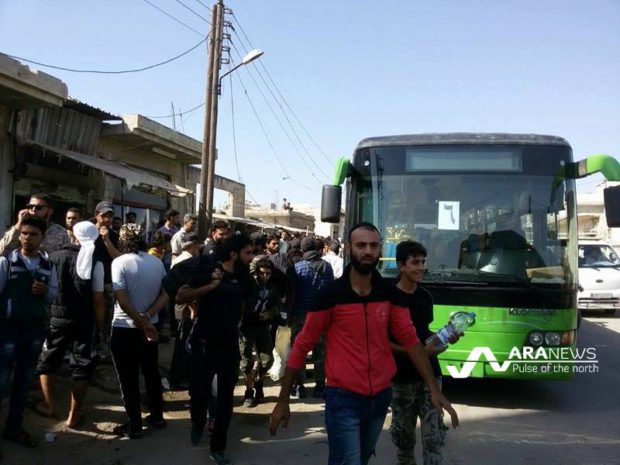The Assad regime has devised various plots to take control of opposition cities and towns opposed to it, but the plot which has had the most success so far began in June 2012, when the regime created the National Reconciliation Ministry and appointed Dr. Ali Haidar as its head. The ministry subsequently turned to “reconciliations and settlements” through its negotiators on the ground, an outstretched hand of the regime penetrating the areas it was not able to take control of with its mightiest weapons.
Assad Regime Reveals the Secret of the “Reconciliations”
The capital Damascus is the most important artery for the regime and the greatest proof that it is still in control, and so it has therefore spearheaded many negotiations inside the capital, leading to settlements and the end of the conflicts.
Media activist Mohamed Ibrahim from Damascus told ARA News: “The regime proved through the reconciliation with the Barzeh al-Balad district in Damascus that it was able to make settlements with rebel fighters which appear to be ‘neither conqueror nor conquered’ but really mean that it takes control of the area through its outlets, thereby controlling all movement in and out of it.”
The beginning of 2014 witnessed the “reconciliation” of the Barzeh al-Balad district, which was concluded with agreement to jointly manage the checkpoints in the area between rebel fighters in the district and regime fighters. This occurred after the intervention of those known as “reconciliation dignitaries” under the leadership of Sheikh Macros al-Rafaei, who was well known among the district’s residents.
After this, other areas and districts of Damascus such as the Al-Qaboun neighborhood, Al-Qadam, Qadisiya, and even Old Homs, saw similar truces to the Barzeh al-Balad truce.
But later it became clear that the “reconciliation” or settlement which had been produced in the noted area was not suitable for other areas, and after that they began to plan different methods for conducting settlements.
A researcher in Syrian affairs, Fares Aseel, told ARA News that: “Every area has particular characteristics. This is certain. The regime has recently realized the peculiarities of each district and has begun to impose particular conditions on settlements. What was done in the city of Daraya was not in Moadimiya, and what was in the Waer district was not what was done in Old Homs.”
In accordance with the deal, the regime removed all the residents of Daraya, while it is still finding a “satisfactory” settlement for Moadimiya, even though the two cities are adjacent. Likewise, it made a deal returning the residents of Old Homs to live in Homs but it decided to expel opposition members from the Waer district to northern Syria.
Fares Aseel added, “During every truce or settlement, the regime has used notables or reconciliation leaders to try to balance between the demands of the people of the area where the regime wanted to make a settlement, but they were without the slightest doubt an extension of the regime’s hand (and) would impose its conditions on these areas.”
Are They Double Agents?
The recent imagery of the reconciliation delegation in the Waer district under the leadership of Sheikh Ghazoun al-Saqqa sparked a great deal of anger, as it seemed he had warm relations with the regime leaders as if something had been “plotted under the table.”
The political activist Asaad Deeb told ARA News, “The guarantee of returning to the regime’s embrace requires making specific concessions, the most important of which is giving information about what is happening inside the areas and cities which it is trying to make a settlement with, followed by implementing part of the plan which they are aiming for. All of this is apparent in the appearance of the reconciliation leaders who want to stop the shedding of civilian blood but who are also striving for personal interests.”
The National Reconciliation Ministry was integrated into the regime government to appoint delegations for reconciliation in the areas to serve as “peacemakers,” but members were chosen carefully so that they would be able to “return regime control over the area, but in their own way,” as those close to the ministry say.
This article was translated and edited by The Syrian Observer. Responsibility for the information and views set out in this article lies entirely with the author.


